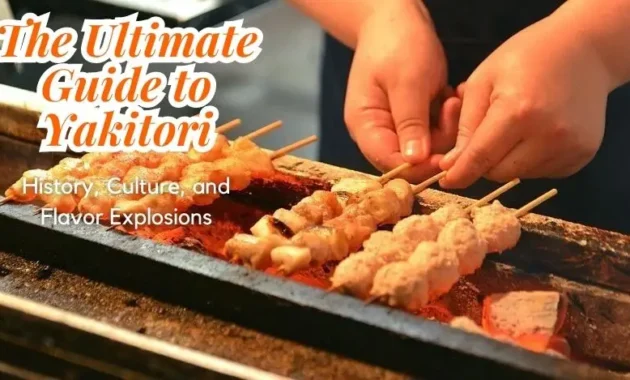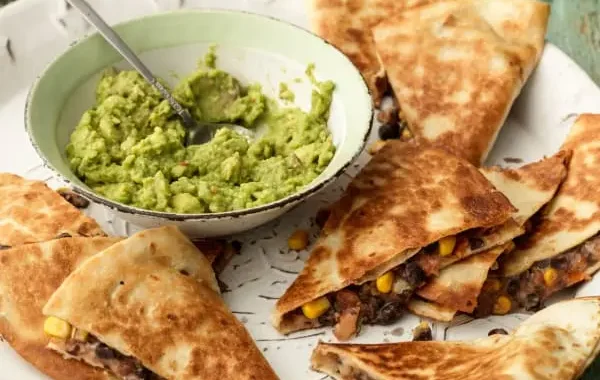What is Yakitori?
Yakitori is a Japanese dish that consists of skewered and grilled chicken. The term “yakitori” translates to “grilled bird,” and it’s a popular street food in Japan, as well as a staple in many Japanese restaurants around the world. Here’s everything you need to know about Yakitori:
Definition and Origin of Yakitori
Yakitori originated in Japan in the Edo period (1603-1868) and was originally made with quail eggs and meat. It later evolved to include chicken meat, which became the primary ingredient. Yakitori is made by skewering small pieces of chicken onto bamboo sticks and grilling them over charcoal. The charcoal imparts a distinct smoky flavor to the meat, which is what makes Yakitori so delicious.
Different Types of Yakitori
There are many different types of Yakitori, and the way the chicken is prepared can vary depending on the region and the restaurant. Here are some popular types of Yakitori:
- Negima: This type of Yakitori is made by skewering small pieces of chicken and alternating them with pieces of green onion. It’s one of the most popular types of Yakitori in Japan.
- Tsukune: Tsukune is made by mixing ground chicken with different spices and seasonings and shaping the mixture into small balls. The balls are then skewered and grilled over charcoal.
- Momo: Momo is made with chicken thigh meat, which is considered the most flavorful part of the chicken. The meat is cut into small pieces and skewered, then grilled over charcoal.
- Sunagimo: Sunagimo is made with chicken gizzard, which is a chewy and flavorful part of the chicken. The gizzard is skewered and grilled over charcoal.
No matter which type of Yakitori you try, you’re in for a burst of flavor and an experience that’s sure to leave you craving more.
Yakitori Culture in Japan
Yakitori is deeply rooted in Japanese cuisine and culture. From street food stalls to high-end restaurants, Yakitori can be found everywhere in Japan. Here’s a closer look at how Yakitori is enjoyed in Japan:
Yakitori in Japanese Cuisine
In Japan, Yakitori is often served as a snack or appetizer, but it can also be a main course. It’s commonly paired with beer or sake, and it’s a popular food to enjoy with friends and family. Yakitori is often served with a variety of dipping sauces, including soy sauce, teriyaki sauce, and salt.
Yakitori Restaurants and Bars in Japan
In Japan, there are many Yakitori restaurants and bars, called Yakitori-ya, that specialize in serving Yakitori. These establishments often feature an open kitchen where customers can watch the chefs prepare the Yakitori over charcoal. Some Yakitori-ya has been in business for generations, and they take great pride in their craft.
Yakitori Festivals and Events in Japan
Throughout Japan, there are many Yakitori festivals and events, especially during the summer months. These festivals feature a wide variety of Yakitori, including unique and creative twists on traditional Yakitori. They also include games, live music, and other entertainment.
If you’re ever in Japan, be sure to try Yakitori at a Yakitori-ya or at one of the many Yakitori festivals. It’s a delicious and unique way to experience Japanese culture and cuisine.
The Art of Making Yakitori
Yakitori is not only a delicious food, but it’s also an art form. The key to making great Yakitori is in the preparation and grilling. Here’s what you need to know to create your own Yakitori masterpiece:
Ingredients and Tools Needed to Make Yakitori
Yakitori is made with small pieces of chicken that are skewered and grilled over charcoal. Here are the ingredients and tools you’ll need to make Yakitori at home:
Ingredients:
- Chicken (thighs, breasts, or wings)
- Scallions
- Salt
- Soy sauce
- Sake
- Sugar
- Mirin (sweet rice wine)
Tools:
- Skewers (bamboo or metal)
- Grill (charcoal or gas)
- Basting brush
- Tongs
Yakitori Grilling Techniques
Grilling Yakitori is an art form that requires patience and skill. To achieve the perfect Yakitori, the chicken needs to be cooked over high heat, but not for too long. Here are some tips for grilling Yakitori:
- Start with clean, oiled grates to prevent sticking.
- Preheat your grill to high heat.
- Skewer the chicken and scallions, alternating them.
- Grill the Yakitori, turning frequently, until the chicken is cooked through and slightly charred on the outside.
- Baste the Yakitori with a mixture of soy sauce, sake, sugar, and mirin to add flavor and moisture.
Yakitori Dipping Sauces and Seasonings
To elevate the flavor of Yakitori, it’s often served with a variety of dipping sauces and seasonings. Here are some common Yakitori dipping sauces:
- Tare: a sweet and salty sauce made with soy sauce, sake, sugar, and mirin
- Ponzu: a citrusy sauce made with soy sauce and citrus juice
- Shichimi Togarashi: a spicy seasoning made with seven different spices, including chili pepper, orange peel, and sesame seeds
Making your own Yakitori at home is a fun and delicious way to explore Japanese cuisine. With the right ingredients and tools, and a little bit of practice, you’ll be grilling Yakitori like a pro in no time.
Flavor Explosions: Popular Yakitori Recipes
Yakitori is a versatile dish that can be made with various meats, vegetables, and seasonings. Here are some popular Yakitori recipes that you can try at home:

1. Traditional Yakitori Recipes
- Negima: This is a classic Yakitori recipe made with chicken thigh meat and scallions. The chicken and scallions are skewered alternately, and the skewers are grilled over hot charcoal until the chicken is cooked through and the scallions are slightly charred. It is then seasoned with salt and brushed with a sweet soy sauce glaze.
- Momo: Momo is another traditional Yakitori recipe made with chicken thigh meat. It is similar to Negima but without the scallions. The chicken is grilled until it’s juicy and tender and then brushed with a soy sauce and mirin glaze.
2. Unique and Modern Yakitori Twists

- Tsukune: Tsukune is a chicken meatball Yakitori recipe. Ground chicken is mixed with green onion, ginger, and other seasonings and then formed into small meatballs. The meatballs are skewered and grilled until they’re crispy on the outside and juicy on the inside. They’re then brushed with a sweet and savory Yakitori sauce.
- Butabara: Butabara is a modern Yakitori recipe that uses pork belly instead of chicken. The pork belly is cut into thin strips and skewered. It’s then grilled over charcoal until crispy and caramelized. It’s served with a tangy ponzu sauce.
3. Vegetarian and Non-Chicken Yakitori Options
- Asparagus Bacon Roll: This Yakitori recipe is perfect for vegetarians or those who want to try something different. Asparagus spears are wrapped in bacon and skewered. They’re grilled until the bacon is crispy and the asparagus is tender. It’s served with a sweet and spicy sauce.
- Beef Tongue: Beef tongue Yakitori is a popular dish in Japan. The beef tongue is marinated in a sweet and savory sauce and then grilled until tender. It’s served with a side of salt or a citrusy ponzu sauce.

Yakitori is a delicious and easy-to-make dish that can be enjoyed by everyone. With these recipes, you can enjoy the traditional flavors of Japan or try something new and unique.
Yakitori Around the World
If you think Yakitori is only enjoyed in Japan, think again! Yakitori has become increasingly popular around the world and has taken on different interpretations and fusion cuisines.
Yakitori Popularity and Variations Outside of Japan
With the rise of Japanese cuisine globally, Yakitori has become a favorite among food lovers. Here are some examples of Yakitori variations enjoyed around the world:
- In the Philippines, there is a version of Yakitori called “isaw,” which uses chicken intestines.
- In Korea, Yakitori is known as “chimaek,” which is a combination of fried chicken and beer.
- In the United States, Yakitori is often served with a modern twist, such as using different types of meat and vegetables, or incorporating unique sauces and flavors.
Different Yakitori Interpretations and Fusion Cuisines
As Yakitori has gained popularity worldwide, chefs have been putting their own unique spin on this classic dish. Here are some examples of Yakitori fusion cuisines:
- In Australia, Yakitori has been fused with Mediterranean cuisine to create “Yakitori skewers with tzatziki sauce.”
- In Canada, Yakitori has been incorporated into poutine, a popular Canadian dish.
- In Brazil, Yakitori has been paired with traditional Brazilian ingredients such as cassava and spicy chili peppers.
It’s exciting to see how Yakitori has evolved and adapted to different cultures around the world. Whether you’re a traditionalist or a fan of fusion cuisine, there’s a Yakitori dish out there for everyone to enjoy!
Yakitori and Japanese Culture
Yakitori has not only become a staple in Japanese cuisine but also a part of Japanese culture. Here are some ways that Yakitori has been incorporated into Japanese art, literature, and entertainment, as well as its significance in Japanese social and dining customs:
Yakitori in Japanese Art, Literature, and Entertainment
- Art: Yakitori has been featured in Japanese art since the Edo period (1603-1868). It can be seen in ukiyo-e (woodblock prints), such as “Yakitori Vendor” by Utagawa Kuniyoshi, which depicts a vendor grilling Yakitori skewers. Yakitori has also been used as a motif in modern Japanese art.
- Literature: Yakitori is mentioned in many Japanese literary works, including in Yasunari Kawabata’s novel “The Old Capital” and Haruki Murakami’s short story “Tony Takitani.” Yakitori has also inspired literature, such as “Yakitori Taisho” by Shinji Ishihara, which tells the story of a Yakitori restaurant in Tokyo.
- Entertainment: Yakitori has been featured in Japanese movies and TV shows, such as the comedy-drama series “Midnight Diner” and the film “Tampopo,” which explores Japanese cuisine.
The Significance of Yakitori in Japanese Social and Dining Customs
- Izakayas: Yakitori is often served in izakayas, which are informal Japanese pubs. Izakayas are a popular place for socializing and eating with friends or colleagues, and Yakitori is a common dish on the menu.
- Festivals and Events: Yakitori is often served at Japanese festivals and events, such as summer matsuri (festivals), where vendors grill Yakitori skewers on the streets.
- Sharing Culture: Yakitori is often shared among friends and family in Japan. It is common to order several different types of Yakitori skewers and share them with the group.
- Informal Dining: Yakitori is often eaten in an informal setting, such as standing at a Yakitori stall or sitting on bar stools in an izakaya. This casual dining style reflects the relaxed and social atmosphere of Japanese culture.
Yakitori is not only a delicious dish but also a significant part of Japanese culture. Its presence in art, literature, and entertainment, as well as its role in Japanese social and dining customs, has made Yakitori a beloved and iconic aspect of Japanese cuisine.
Yakitori Tips and Recommendations
Are you ready to grill some Yakitori at home or explore the world of Yakitori dining? Check out these tips and recommendations to make the most of your Yakitori experience.
Tips for grilling Yakitori at home
Making Yakitori at home is a fun and delicious way to enjoy this Japanese favorite. Here are some tips to make sure your Yakitori turns out perfectly:
- Choose the right cut of chicken: Use boneless, skinless chicken thighs for the best flavor and texture. Cut them into bite-sized pieces and skewer them with bamboo sticks.
- Soak the skewers: Soak the bamboo skewers in water for at least 30 minutes to prevent them from burning on the grill.
- Use a good grill: Whether you’re using a traditional charcoal grill or a gas grill, make sure it’s hot and clean before you start grilling.
- Baste with sauce: Brush the Yakitori with a sweet soy sauce or other Yakitori sauce while grilling to add flavor and keep the chicken moist.
Best Yakitori restaurants to visit in Japan and around the world
If you want to taste some of the best Yakitori in the world, check out these top restaurants:
In Japan:
- Toriyoshi in Tokyo: This popular Yakitori restaurant has been serving up delicious skewers for over 60 years.
- Fuku in Osaka: This Yakitori restaurant offers a wide range of skewers, from traditional to unique flavors like cheese and mentaiko.
- Kushikatsu Daruma in Osaka: This restaurant specializes in kushikatsu, a type of fried skewer that pairs well with Yakitori.
Around the world:
- Yardbird in Hong Kong: This trendy Yakitori restaurant is known for its modern twists on traditional Yakitori.
- Raku in Las Vegas: This upscale Japanese restaurant serves up some of the best Yakitori in the United States.
- Sumibi Yakiniku Tora in Sydney: This Japanese BBQ restaurant offers a variety of grilled dishes, including Yakitori, made with fresh and high-quality ingredients.
Recommended Yakitori and drink pairings
Pairing Yakitori with the right drink can enhance the flavors and make your dining experience even more enjoyable. Here are some recommended Yakitori and drink pairings:
- Sake: This Japanese rice wine is a classic pairing with Yakitori, as its mild flavor complements the chicken and enhances the Yakitori sauce.
- Beer: A cold beer pairs well with the salty and savory flavors of Yakitori, especially when you’re grilling at home.
- Highball: A highball, which is a mix of whiskey and soda, is a refreshing and crisp drink that pairs well with the bold flavors of Yakitori.
So there you have it, some tips, recommendations, and pairings to help you enjoy Yakitori to the fullest!
Conclusion
Yakitori is a beloved dish in Japan and around the world, known for its mouthwatering flavors and cultural significance. Let’s recap some of the key points we covered in this article:
- Yakitori is a Japanese cuisine that features grilled chicken skewers with a variety of seasonings and dipping sauces.
- Yakitori can be found in restaurants, bars, festivals, and events throughout Japan.
- The art of making Yakitori involves using specific ingredients, tools, and grilling techniques to achieve the perfect flavor and texture.
- Popular Yakitori recipes include traditional options as well as unique and modern twists, with vegetarian and non-chicken options also available.
- Yakitori has gained popularity and variation outside of Japan, with different interpretations and fusion cuisines.
- Yakitori has a significant presence in Japanese art, literature, and entertainment, as well as social and dining customs.
- To enjoy Yakitori at home, it’s important to follow proper grilling tips and techniques. And, for those looking to experience the dish in person, there are many great Yakitori restaurants to choose from in Japan and around the world.
- Finally, we recommend trying Yakitori with different drink pairings to enhance the overall flavor experience.
Yakitori is a culinary delight that brings together Japanese culture and cuisine. Whether you’re a seasoned Yakitori lover or trying it for the first time, we hope this article has given you a greater appreciation for this delicious dish.


